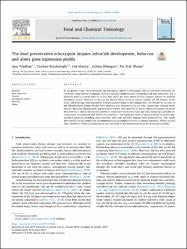| dc.contributor.author | Pradhan, Ajay | |
| dc.contributor.author | Bereketoğlu, Ceyhun | |
| dc.contributor.author | Martin, Lea | |
| dc.contributor.author | Duhagon, Justine | |
| dc.contributor.author | Olsson, Per-Erik | |
| dc.date.accessioned | 2020-05-24T15:31:53Z | |
| dc.date.available | 2020-05-24T15:31:53Z | |
| dc.date.issued | 2020 | |
| dc.identifier.citation | Pradhan, A., Bereketoglu, C., Martin, L., Duhagon, J., & Olsson, P. E. (2020). The food preservative ethoxyquin impairs zebrafish development, behavior and alters gene expression profile. Food and chemical toxicology : an international journal published for the British Industrial Biological Research Association, 135, 110926. https://doi.org/10.1016/j.fct.2019.110926 | en_US |
| dc.identifier.issn | 0278-6915 | |
| dc.identifier.issn | 1873-6351 | |
| dc.identifier.uri | https://doi.org/10.1016/j.fct.2019.110926 | |
| dc.identifier.uri | https://hdl.handle.net/20.500.12508/1145 | |
| dc.description | Pradhan, Ajay/0000-0003-2305-8574 | en_US |
| dc.description | WOS: 000509791400034 | en_US |
| dc.description | PubMed ID: 31676350 | en_US |
| dc.description.abstract | In the present study, we investigated the detrimental effects of ethoxyquin (EQ) on zebrafish embryonic development using different endpoints including lethality, malformations, locomotion and gene expression. EQ is primarily used as a preservative in animal feed and it has been shown to have negative impacts on different laboratory animals. However, studies on the adverse effects of EQ in aquatic animals are still limited. In this study, zebrafish eggs were exposed to different concentrations of EQ ranging from 1 to 100 mu M for six days. In the 100 mu M treated groups 95 and 100% mortality was observed at 24 and 48 h, respectively. Delayed development, decreased pigmentation and pericardial edema were observed in larvae. Behavioral analysis of larvae demonstrated a distinct locomotive pattern in response to EQ both in light and dark indicating a possible developmental neurotoxicity and deficits in locomotion. The expression levels of genes involved in several physiological pathways including stress response, cell cycle and DNA damage were altered by EQ. Our results demonstrate that EQ could cause developmental and physiological toxicity to aquatic organisms. Hence, its toxic effect should be further analyzed and its use and levels in the environment must be monitored carefully. | en_US |
| dc.description.sponsorship | Knowledge Foundation, Sweden; Orebro University | en_US |
| dc.description.sponsorship | This study was financed by Knowledge Foundation, Sweden, and Orebro University. | en_US |
| dc.language.iso | eng | en_US |
| dc.publisher | Pergamon-Elsevier Science Ltd | en_US |
| dc.relation.isversionof | 10.1016/j.fct.2019.110926 | en_US |
| dc.rights | info:eu-repo/semantics/closedAccess | en_US |
| dc.subject | Gene expression | en_US |
| dc.subject | Toxicity | en_US |
| dc.subject | Development defects | en_US |
| dc.subject | Mortality | en_US |
| dc.subject | Edema | en_US |
| dc.subject.classification | Food Science & Technology | en_US |
| dc.subject.classification | Toxicology | en_US |
| dc.subject.classification | Ethoxyquin | Dietary exposure | Atlantic salmon | en_US |
| dc.subject.other | II biotransformation enzymes | en_US |
| dc.subject.other | Salmon salmo-salar | en_US |
| dc.subject.other | Oxidative stress | en_US |
| dc.subject.other | Motor behavior | en_US |
| dc.subject.other | Synthetic antioxidant | en_US |
| dc.subject.other | Axonal growth | en_US |
| dc.subject.other | Heat-shock | en_US |
| dc.subject.other | Phase-i | en_US |
| dc.subject.other | Fish | en_US |
| dc.subject.other | Damage | en_US |
| dc.subject.other | Adverse outcome | en_US |
| dc.subject.other | Animal cell | en_US |
| dc.subject.other | Animal experiment | en_US |
| dc.subject.other | Animal model | en_US |
| dc.subject.other | Animal tissue | en_US |
| dc.subject.other | Article | en_US |
| dc.subject.other | Behavior assessment | en_US |
| dc.subject.other | Behavior disorder | en_US |
| dc.subject.other | Cell cycle progression | en_US |
| dc.subject.other | Cellular stress response | en_US |
| dc.subject.other | Concentration (parameter) | en_US |
| dc.subject.other | Developmental delay | en_US |
| dc.subject.other | DNA damage | en_US |
| dc.subject.other | Embryo | en_US |
| dc.subject.other | Embryo development | en_US |
| dc.subject.other | Gene expression | en_US |
| dc.subject.other | Gene expression profiling | en_US |
| dc.subject.other | Locomotion | en_US |
| dc.subject.other | Mortality rate | en_US |
| dc.subject.other | Neurotoxicity | en_US |
| dc.subject.other | Nonhuman | en_US |
| dc.subject.other | Pericardial disease | en_US |
| dc.subject.other | Pigment disorder | en_US |
| dc.subject.other | Quantitative analysis | en_US |
| dc.subject.other | Real time polymerase chain reaction | en_US |
| dc.subject.other | Toxicity testing | en_US |
| dc.subject.other | Animal | en_US |
| dc.subject.other | Drug effect | en_US |
| dc.subject.other | Embryo development | en_US |
| dc.subject.other | Embryology | en_US |
| dc.subject.other | Nonmammalian embryo | en_US |
| dc.subject.other | Zebra fish | en_US |
| dc.subject.other | Ethoxyquin | en_US |
| dc.subject.other | Food preservative | en_US |
| dc.subject.other | Transcriptome | en_US |
| dc.title | The food preservative ethoxyquin impairs zebrafish development, behavior and alters gene expression profile | en_US |
| dc.type | article | en_US |
| dc.relation.journal | Food And Chemical Toxicology | en_US |
| dc.contributor.department | Mühendislik ve Doğa Bilimleri Fakültesi -- Biyomedikal Mühendisliği Bölümü | en_US |
| dc.identifier.volume | 135 | en_US |
| dc.relation.publicationcategory | Makale - Uluslararası Hakemli Dergi - Kurum Öğretim Elemanı | en_US |
| dc.contributor.isteauthor | Bereketoğlu, Ceyhun | en_US |
| dc.relation.index | Web of Science Core Collection - Science Citation Index Expanded | en_US |
















